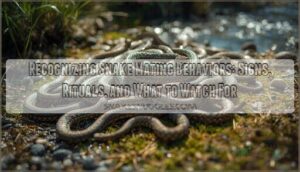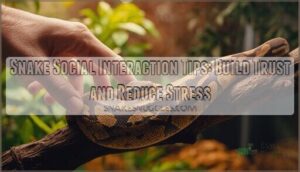This site is supported by our readers. We may earn a commission, at no cost to you, if you purchase through links.

Their reputation stems not from myth but from the sharp instincts refined by a life that rewards caution and cleverness. If you want to understand what it’s like living alongside one, you’ll need to appreciate the nuances in their mood, the subtle cues in their posture, and the dance between trust and self-protection.
Table Of Contents
- Key Takeaways
- Reticulated Python Temperament Explained
- Key Factors Affecting Temperament
- Defensive and Aggressive Behaviors
- Safely Handling Reticulated Pythons
- Building Trust With Your Reticulated Python
- Frequently Asked Questions (FAQs)
- Can a reticulated python be kept as a cuddly pet?
- Do reticulated pythons enjoy swimming in water?
- How can I establish trust with my reticulated python?
- What precautions should I take when handling a defensive reticulated python?
- What health issues affect reticulated python behavior?
- How does diet influence a reticulated python’s mood?
- Are reticulated pythons more active during certain seasons?
- Do enclosure size and design impact temperament?
- Can reticulated pythons identify and remember individual people?
- Conclusion
Key Takeaways
- Reticulated pythons are naturally watchful and defensive, with sharp instincts that make their reactions quick and sometimes unpredictable.
- Their temperament varies widely depending on whether they are wild-caught or captive-bred, the environment they’re kept in, and how they’ve been handled from a young age.
- Recognizing subtle changes in their posture and behavior is crucial, as stress or fear can quickly turn a calm snake defensive or even aggressive.
- Building trust with these snakes depends on consistent, gentle interaction, a secure environment, and respecting their clear boundaries.
Reticulated Python Temperament Explained
Understanding the temperament of a reticulated python is key to keeping them safely and comfortably. Their personalities can vary quite a bit depending on age, environment, and background.
Let’s look at what you can expect from their behavior in different settings.
Typical Personality Traits
When you spend time around reticulated pythons, you’ll notice they tend to be more alert and defensive than many other snakes, relying on their sharp instincts to navigate both new and familiar environments. Their temperament can vary, but you’ll often see:
- Individual Variation in defensive behaviors
- Docile retics showing calm Reticulated Python Behavior
- High Intelligence Levels and strong Problem Solving skills
Comparison With Other Python Species
You’ll notice temperament differences across python species. Reticulated pythons stand out for their sharper instincts and unpredictable snake behavior, especially compared to the calmer Burmese or ball pythons. Their size and care difficulties add another layer, and their predatory behavior is more pronounced. As detailed in a comparison, Burmese pythons are generally more docile. Here’s a quick look:
| Species | Temperament | Size |
|---|---|---|
| Reticulated | Defensive | Largest |
| Burmese | Docile | Large |
| Ball Python | Calm | Small-Medium |
Wild Vs. Captive-Bred Temperament
Compared to their docile cousins, wild-caught specimens show sharper defensive behavior and aggressive tendencies—especially during the first months of captivity. Captivity stress runs high, but captive breeding and careful management differences lead to calmer reticulated python temperament.
These snakes are known as some of the largest snakes in the world, sometimes exceeding 20 feet in length. With proper acclimation periods and behavioral modification, you’ll see captive-bred snakes adapt quickly, displaying fewer stress responses and safer interactions.
Key Factors Affecting Temperament
Several things can shape how a reticulated python behaves day to day. The way they’re raised, their unique personalities, and the environment you provide all play a part.
Let’s look at what influences their temperament most.
Age and Early Socialization
Did you know that a reticulated python’s temperament can shift dramatically as it grows, much like a storm changing course with the seasons? Early experiences play a key role in temperament shaping.
Consider these factors:
- Hatchling Defensiveness peaks in young snakes
- Juvenile Interaction builds trust
- Socialization Benefits reduce reticulated python aggression
- Interaction Tips support establishing trust with retics
Individual Personality Differences
While you might expect reticulated python behavior to follow a set pattern, individual personality differences are striking. Some show high Curiosity Levels, exploring new objects or changes in territory size, while others remain reserved.
Caretaker Recognition is common, with certain snakes responding differently to familiar scents. Mirror Reactions also vary, revealing the depth of behavioral variability and animal behavior.
Impact of Handling and Environment
If you’ve ever watched a reticulated python settle into a new enclosure or respond to gentle interaction, you’ll see firsthand how much their temperament can shift based on their surroundings and your approach. Factors like Interaction Frequency, Enclosure Size, and Enrichment Activities all play a role in Stress Reduction and Environmental Enrichment, shaping Reticulated Python behavior.
- A spacious enclosure calms nerves.
- Regular, gentle interaction builds trust.
- Enrichment Activities spark curiosity.
- Sudden changes may trigger aggressive behavior.
- Predictable routines lower Reticulated Python aggression.
Defensive and Aggressive Behaviors
Understanding how reticulated pythons respond when they feel threatened is key to keeping both you and your snake safe. Their behavior can shift quickly from calm to defensive, so it’s important to recognize what sets them off.
Here are the main ways these snakes show stress, aggression, and predatory instincts.
Signs of Stress and Fear
Spotting a reticulated python’s stress is a bit like reading a stormy sky—subtle shifts in their body language can warn you when trouble is brewing. Watch for increased hissing frequency, erratic movements, defensive postures, and food refusal. Scale changes may also signal discomfort.
These signs often precede aggressive behavior, so recognizing them is key for snake behavior and safety.
Defensive Displays and Striking
When a reticulated python feels threatened, its defensive display can unfold with all the drama of a thunderclap—hissing, body inflation, and a lightning-fast strike that leaves little room for hesitation.
Knowing how these defensive moves work—including how far the snake can strike and how serious a bite might be—makes it easier to spot warning signs and take steps to avoid snake bites, especially if you’re faced with an aggressive reticulated python.
Predatory Instincts and Triggers
Imagine a creature whose hunger can turn patience into precision, waiting in silence until the perfect moment to exert its power.
Reticulated python aggression often emerges from:
- Sudden Feeding Response triggered by movement
- Territorial disputes during Wild Encounters
- Ambush Tactics honed by their natural Hunting Strategies and Prey Preference
Their predatory instincts drive bite attempts with considerable speed and accuracy.
Documented Attacks on Humans
Did you know Reticulated Python attacks on humans, though rare, have made headlines across Southeast Asia? Attack Frequency averages just one or two deaths yearly, with most aggressive encounters happening in rural Indonesia and the Philippines.
Victim Demographics often include adult males working alone.
Legal Implications now restrict ownership, reflecting the real risks tied to snake bite and attack circumstances.
Safely Handling Reticulated Pythons
Working with a reticulated python safely starts with choosing the right enclosure. Your setup can make all the difference in how secure and comfortable both you and your snake feel.
Let’s look at some options that work well for these impressive animals.
Proper Handling Techniques
Because these snakes can be unpredictable, learning the right way to work with a reticulated python is essential for both your safety and the animal’s well-being.
Use equipment like hooks for safe restraint methods, and always recognize cues of stress. Solo interaction isn’t recommended—teamwork reduces risk.
Careful interaction tips help you avoid injury and support responsible pet safety.
Timing and Environment for Handling
Once you’ve got the basics of care down, choosing the right moment and setting can make all the difference in keeping both you and your python relaxed. For best care time, consider these four tips:
- Care after feeding, not before.
- Confirm enclosure security.
- Provide environmental enrichment.
- Reduce stress by observing your python’s behavior.
Safety Precautions With Large Snakes
If you’re working with a reticulated python that’s grown to impressive size, your safety plan matters just as much as the timing and setting of each interaction.
Enclosure security and restricting movement are critical during restraint, especially around feeding.
Always keep clear emergency procedures and first aid supplies within reach so you’re prepared for bites or unexpected bursts of aggression.
Reticulated pythons can surprise you, so never take their defensive instincts lightly.
Recognizing When to Seek Help
Even with careful planning and solid safety routines, there are moments when reaching out for expert advice or medical attention is the wisest move for both you and your python.
Don’t ignore escalating aggression, unexplained changes in activity or feeding, repeated difficulties interacting, or your own limitations. Serious bite attempts and attacks point to a need for expert consultation before things spiral.
Building Trust With Your Reticulated Python
Building trust with your reticulated python takes time and patience, but it starts with the right approach. The way you interact and care for your snake makes a big difference.
Here are a few key steps you can take to help things go smoothly.
Consistent and Positive Interaction
Building trust with these powerful snakes starts a lot like any good friendship—through steady, thoughtful actions and a calm, patient approach.
Keep your interaction routine consistent, using positive reinforcement to reward calm responses. Simple bonding techniques—like gentle, predictable movements—reduce stress and help your reticulated python recognize progress.
Regular, respectful interactions set the foundation for safer, less defensive behaviors.
Encouraging Calm Behavior
With just a little patience and a steady hand, you’ll find your reticulated python responds best when the atmosphere is peaceful and free from surprises. Try these five steps for calm:
- Positive Reinforcement
- Secure Enclosures
- Gradual Introduction
- Enrichment Techniques
- Reducing Stress through gentle, consistent interaction Tips—essential for minimizing aggressive responses and effective Reticulated Python interaction techniques.
Avoiding Common Handling Mistakes
While it’s easy to get caught up in the excitement of interacting with your python, a few simple missteps can quickly turn a calm interaction into a stressful one for both of you.
Always read body language before lifting, and maintain a secure grip.
Too much interaction or ignoring limits fuels reticulated python aggression—respect the snake’s space to avoid bites and build trust.
Developing a Long-Term Bond
Trust with a reticulated python isn’t handed over in a day—think of it as a slow dance, where patience and consistency guide every step. Build mutual benefit with your pet retics by:
- Respecting boundaries during interaction
- Keeping a consistent routine
- Using enrichment activities for engagement
- Reading cues carefully to adapt your Reticulated Python interaction techniques
Frequently Asked Questions (FAQs)
Can a reticulated python be kept as a cuddly pet?
Ever wonder if a reticulated python will curl up for a snuggle? The reality is, Python Affection runs cold.
Managing Risks and Temperament Realities mean pet retics rarely act cuddly—and management tips matter.
Do reticulated pythons enjoy swimming in water?
Reticulated pythons aren’t shy about water. Their aquatic behavior is well established—these snakes are natural swimmers.
Swimming adaptations, like sleek bodies, help with habitat immersion, hydration needs, and water enrichment in skilled Reticulated Python care.
How can I establish trust with my reticulated python?
Earning a reticulated python’s trust means respecting boundaries, using gradual introduction, and practicing scent familiarization. Keep a predictable routine and employ positive reinforcement.
Following proven reticulated python interaction techniques provides safe, rewarding snake interaction and meaningful engagement.
What precautions should I take when handling a defensive reticulated python?
Pay close attention to reading body language and always approach with calm, deliberate movement.
Use safe restraint and manipulation tools to avoid bites.
It’s essential to have emergency procedures in place, especially when working with aggressive or defensive reticulated pythons, so you’re always prepared for any situation.
What health issues affect reticulated python behavior?
Parasitic infections, respiratory distress, and Inclusion Body Disease (IBD) can trigger sudden aggression and defensive behaviors in reticulated pythons.
Veterinary care is essential since some snakes show genetic predispositions that make their health—and temperament—more unpredictable.
How does diet influence a reticulated python’s mood?
Picture serving salad to a carnivore—results would get lively fast.
For a Reticulated Python, Prey Size, Feeding Frequency, and Nutritional Deficiencies tweak mood, drive Aggression and defensive behaviors, and reset the gut microbiome.
Are reticulated pythons more active during certain seasons?
Seasonal activity shifts are common in the reticulated python. During breeding season, these snakes become more active, while lower temperatures or changes in environmental factors can reduce their movement—a distinct pattern seen throughout their natural habitat and history.
Do enclosure size and design impact temperament?
Spacious setups and smart design spark significant behavioral changes. An undersized snake enclosure often leads to stress, while complex, enriched environments foster a calmer Reticulated Python.
Enclosure size and enrichment impact temperament and stress reduction every single day.
Can reticulated pythons identify and remember individual people?
Through Individual Recognition and sophisticated cognitive abilities, reticulated pythons likely distinguish people by Scent Discrimination.
Memory Span reinforces this, allowing them to associate gentle interaction or aggressive encounters, shaping responses as seen in reticulated python attacks on humans.
Conclusion
Much like reading a shifting sky, understanding the temperament of a reticulated python means respecting moods you can’t always predict. With vigilance, patience, and the right safety measures, living alongside such intelligence turns caution into wisdom.
Their personalities blend nature and nurture, carrying both ancestral instincts and individual quirks. If you’re willing to listen—and adapt—these snakes become more than a risk to manage. They transform into teachers about boundaries, trust, and the art of attentive cohabitation.
Reticulated pythons teach us that true understanding means respecting both their instincts and the trust earned through patient care
- https://reptilesmagazine.com/handling-reticulated-pythons/
- https://www.bbc.com/news/world-asia-39427462
- https://www.petmd.com/reptile/species/reticulated-python
- https://www.reddit.com/r/snakes/comments/1ggfkxg/multiple_people_handling_one_retic_pythontruth_or/
- https://reptifiles.com/reticulated-python-care-sheet/













